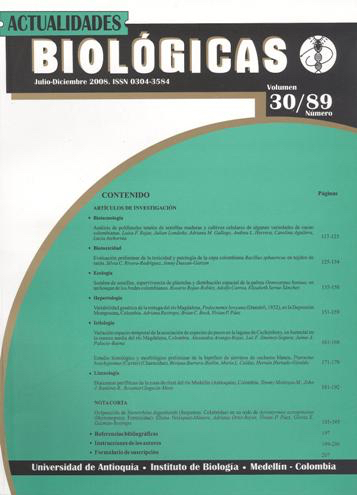Análise de polifenóis totais de sementes maduras e culturas de células de algumas variedades de cacau colombiano
DOI:
https://doi.org/10.17533/udea.acbi.4739Palavras-chave:
biotecnología vegetal, metabolitos secundarios, polifenoles, Theobrema cacaoResumo
O objetivo desta pesquisa foi o estabelecimento de suspensões celulares de cacau (Theobroma cacao) para analisar o teor de polifenóis totais em duas variedades de cacau colombiano e comparar esses resultados com o teor total de polifenóis para as mesmas variedades de campo. Os resultados finais mostraram que é possível produzir uma grande quantidade de biomassa de cacau capaz de sintetizar os metabólitos sem perder suas propriedades organolépticas (cheiro, cor e sabor), e produzir um teor de polifenóis totais aceitável em relação às sementes naturais. Este estudo preliminar é uma perspectiva promissora para a produção futura de antioxidantes e suplementação com eles em produtos derivados do cacau.
Downloads
Referências
bhojwani ss, razdan mK. 1996. Plant tissue culture: Theory and practice, a revised edition. elvesier scien-ce. Amsterdam.
Cooper K, donovan J, Waterhouse a, Williamson G. 2008. cocoa and health: a decade of research. British Journal of Nutrition, 99(1):1-11.
Cakirer m. 2003. Color as an indicator of flavonol content in the fresh seeds of Theobroma cacao. the penns-ylvania state university. <http://guiltinanlab.cas.psu.edu/publications/cocoa/melisthesis.pdf>. fecha de consulta: 21 de febrero de 2007.
Dixon ra, paiva n. 1995. stress-induced phenylpropanoid metabolism. Plant Cell, 7(7):1085-1097.delledone m, Xia y, dixon r, lamb c. 1998. nitric oxide functions as a signal in plant disease resistance. Nature
(6693):585-588.
Durner J, Gow a, stamler J, Glazebrook J. 1998. Ancient origins of nitric oxide signaling in biological systems. Proceedings of the National Academy of Sciences, 95(25):14206-14207.
Giorgi a, mingozzi m, madeo m, speranza G, cocucci, m. 2009. effect of nitrogen starvation on the pheno-lic metabolism and antioxidant properties of yarrow (Achillea collina becker ex rchb.) Food Chemistry, 114(1):204-211.
Grace sc, logan ba. 2000. energy dissipation and radical scavenging by the plant phenylpropanoid pathway.Philosophical Transactions of the Royal Society B: Biological Sciences, 355:1499-1510
Gurney K, evans l, robinson d. 1992. purine alkaloid production and accumulation in cocoa callus and suspension cultures. Journal of Experimental Botany,43(6):769-775.
Hammerstone Jf, schmitz hh. 1998. cocoa components, edible products having enhanced polyphenol content, methods of making same and medical uses. patent cooperation treaty (pct) Wo 98/09533, mars incor-porated, u.s.A.
Henderson J, Joyce r, halls G, hurst J, mcGovern p.2007. chemical and archaeological evidence for the earliest cocoa beverages. Proceedings of the National Academy of Sciences, 104(48):18937-18940.
Jacobs m, rubery p. 1998. naturally occurring auxin trans-port regulators. Science, 241:346-349.
Jalal m, collin h. 1979. secondary metabolism tissue culture of Theobroma cacao. New Phytologist, 83(2):343-349.
Janick J, pence vc. 1980. method of non-agricultural pro-duction of cotyledons. us patent 4.204.366. Purdue research foundation, West lafayette, in.
Janick J, pence vc. 1981. plant tissue produced by non-agricultural proliferation of cocoa embryos. us patent 4.301.619. Purdue research foundation, West lafa-yette, in.Kim h, Keeney pG. 1984. (-)epicatechin content in fer-mented and unfermented cocoa beans. Journal of Food Science, 49:1090-1092.
Keen c, holt r, oteiza p, fraga c, schmitz h. 2005. co-coa antioxidants and cardiovascular health. American Journal of Clinical Nutrition, 81(1):298s-303s.
Leathers rr, scragg ah. 1989. the effect of different temperatures on the growth, lipid content and fatty acid composition oftheobroma cacao cell suspension cultures. Plant Science, 62(2):217-227.
Loewus fa. 1999. biosynthesis and metabolism of ascorbia acid in plants and of analogs of ascorbic acid in fungi. Phytochemistry, 52:193-210.
Ramachandra s, ravishankar G. 2002. plant cell cultures: chemical factories of secondary metabolites. Biotech-nology Advances, 20:101-153.
Romanczyk lJ, hammerstone, Jf, buck mm, post ls, cipolla GG, micceland ca, mundt Ja, schmitz hh. 1997. cocoa extracts compounds and methods for making and using the same. patent cooperation treaty (pct) Wo 97/36497, mars incorporated, u.s.A.
Seet he. 1973. Plant Tissue and Cell Culture. blackwell Scientific Publications. London, England.
Tsai c, Kinsella J. 1981. initiation and growth of callus and cell suspensions of Theobroma cacaol. Annals of Botany, 48:549-558.
Tsai c, Kinsella J. 1982. tissue culture of cocoa bean ( Theobroma cacaol.): incorporation of fatty acids into lipids of cultured cells. Lipids, 17(12):848-852.
Winkel-shirley b. 2002. Biosynthesis of flavonoids end effects of stress. Current Opinion in Plant Biology,5:218-223.
Wollgast J, anklam e. 2000. review on polyphenols in Theobroma cacao: changes in composition during the manufacture of chocolate and methodology for identifi-cation and quantification. Food Research International, 33:423-447.
Yamasaki h, sakihama y, ikehara n. 1997. flavonoid-peroxidase reaction as a detoxification mechanism of plant cells against H2o2. Plant Physiology, 115:1405-1412.
Yamasaki h, Grace s. 1998. epr detection of phytophe-noxyl radicals stabilized by zinc ions: evidence for the redox-coupling of plant phenolics with ascorbate in the H2o2-peroxidase system. FEBS Letters, 422:377-380.
Downloads
Publicado
Como Citar
Edição
Seção
Licença
Copyright (c) 2010 Actualidades Biológicas

Este trabalho está licenciado sob uma licença Creative Commons Attribution-NonCommercial-ShareAlike 4.0 International License.
Os autores autorizam exclusivamente a revista Actualidades Biológicas a editar e publicar o manuscrito submetido, desde que sua publicação seja recomendada e aceita, sem que isso represente qualquer custo para a Revista ou para a Universidade de Antioquia. Todas as ideias e opiniões contidas nos artigos são de responsabilidade exclusiva de Os autores. O conteúdo total das edições ou suplementos da revista é protegido pela Licença Internacional Creative Commons Atribuição-NãoComercial-Compartilhamento pela mesma Licença, portanto não podem ser utilizados para fins comerciais, mas sim para fins educacionais. Porém, cite a revista Actualidades Biológicas como fonte e envie uma cópia da publicação em que o conteúdo foi reproduzido.












